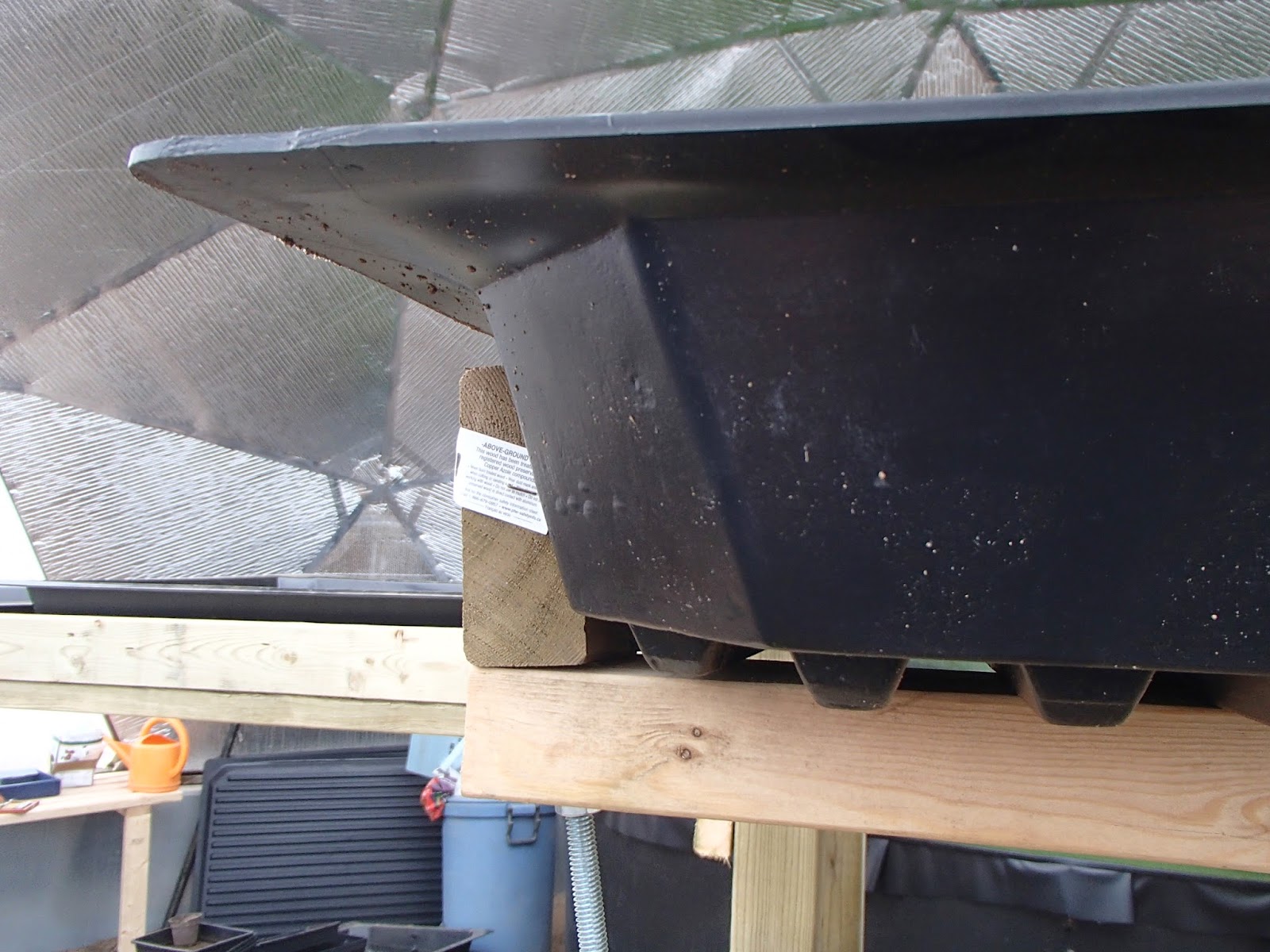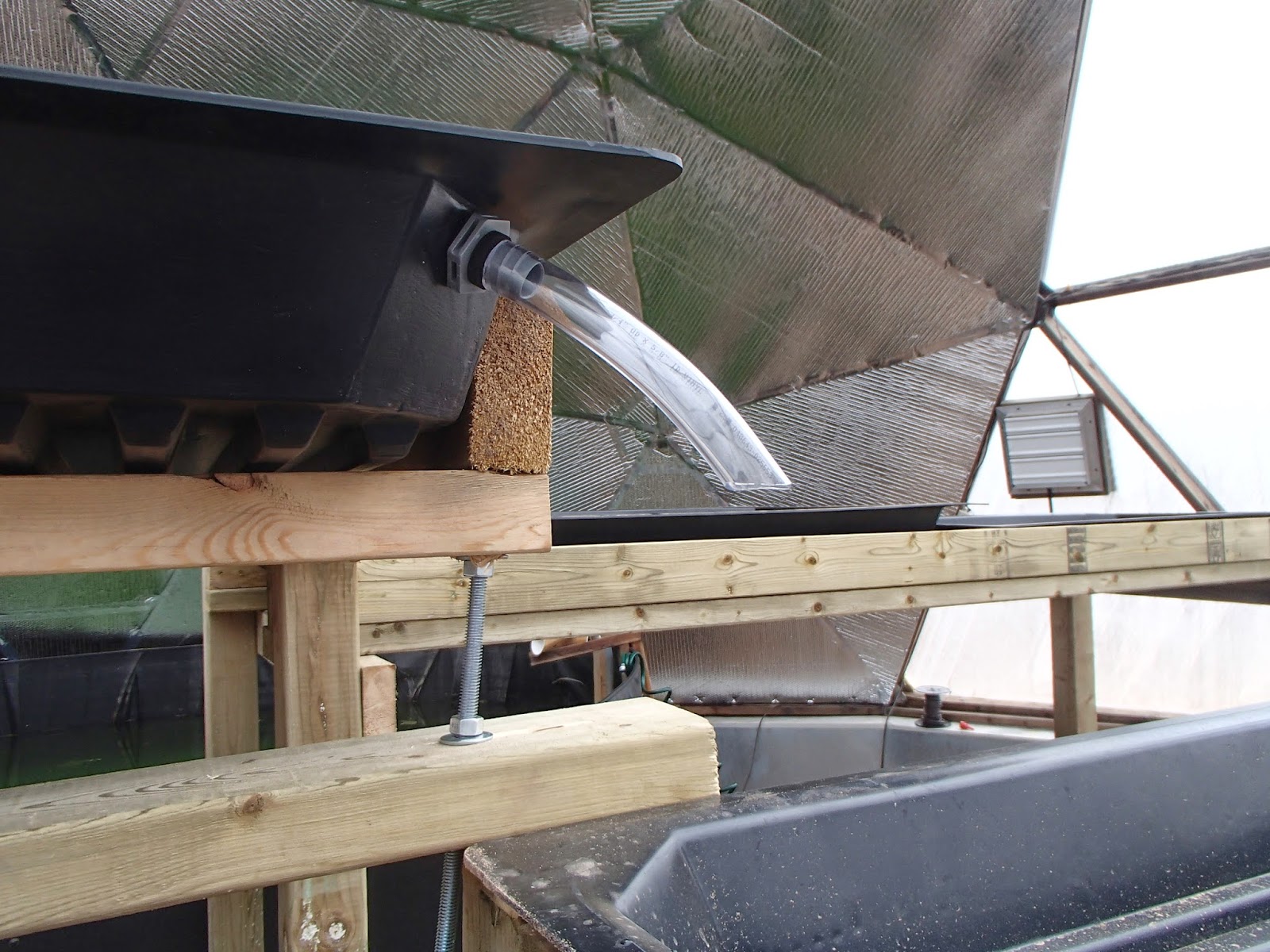To view the latest from Ridge Berry Farm visit our new blog and site!
Now that we are finally enjoying some great Spring weather, we actually ended up spending most of our time "inside"...inside the Growing Dome that is. We had two motivations for getting more active in this "off the grid" greenhouse: 1. our water pipe to the well finally thawed out, and 2. the mainly sunny days allowed us to test our new solar-powered hydroponic configuration.
 |
| Water is finally flowing from the well to the main water tank in the dome. |
Since our early experiments last year, we have been working on a new configuration with our hydroponic tables. The main design constraint is that everything should work based on a single solar-powered water pump. Since we now have 4 sets (of 2) hydroponic beds to feed water to, the key issue has been the distribution of water to these beds. We decided to use one of our spare hydroponic beds as a "holding" tank.
The prefabricated hydroponic beds are rectangular with beveled corners. This meant that we could install outlets at the four corners of a tank to feed our growing beds.
 |
| The beveled corner of a prefabricated hydroponic tank |
The key to the installation would be to achieve a steady flow of water to the four branches of our installation. As such, the leveling of the holding tank and the position of the water feeds would be an issue. We therefore decided to mount the holding tank on a frame with 2 threaded rods which would allow for the adjustment of the tank's tilt.
 |
| The holding tank support frame (upside down). |
It was then time to address the "spouts" or fittings we would use to transfer the water from the holding tank to the hydroponic tables and from the hydroponic tables back to the main tank.
Last year our experiments proved that the standard grommet and tube fittings were not only difficult to water proof but also proved much too small to handle the flow rates from our solar powered bilge pump.
We decided to use and electrical fitting normally used to guide cables across barriers where water may be an issue. these are fitted with an O-ring which we doubled in order to have a good water seal on both sides of the tank walls.
 |
| The new fittings used to tansfer water from one tank to another. |
One additional feature of these fittings is that they fit snugly in tubing with a 5/8 inch inner diameter (standard garden hose dimensions).
The holding tank was equipped with 4 of these fittings as well as each tank in the 4 branches of the assembly.
 |
| Water flow fitting on the holding tank |
 |
| Water flow fitting between hydroponic tanks |
Since our design constraint means that water must return to the main tank via gravity, the last hydroponic bed in each of the 4 branches was fitted with a simple garden hose leading back to that tank.
 |
| Garden hose leading back to the main tank. |
Experiencing a few good days of sunshine, we were able to test the entire system at what would be a maximum flow rate from the bilge pump.
The first results did create a bit of panic. The fittings held up, but after balancing and leveling everything we could, we came to the realization that the flow rates were just too much even once the flow of water was divided into 4. The net effect was an overflow of the hydroponic tables.
To reduce the flow rate we added an "overflow" mechanism at the holding tank (thereby reducing the amount of water distributed to our hydroponic tables. The water overflow went directly to the main tank.
 |
| Holding tank overflow mechanism. |
The net result is that we were finally able to reach a steady state of water through the entire installation at what would be a maximum flow rate.
 |
| The entire system finally running at steady state. |
Of course, things can always go wrong and in our case, once we had everything working....the bilge pump stopped functioning. We're not entirely sure what has happened yet. We simply lost all pressure from the pump and it can longer lift a column of water higher than 6 inches.
In any case, we know we'll be able to overcome this and it's finally time to consider populating the main tank with fish.
With the weather as it was, it was also a great time to work outdoors and this week we received our first root stock ready for planting: Haskaps.
Not many are familiar with the Haskap. Haskap is the Japanese (Ainu) name for the edible Blue Honeysuckle and the word means "berry of good vision and long life". It is native to large regions of the Northern Hemisphere and is found wild in every Canadian Province with the exception of BC.
This berry is actually related to the tomato and the varieties available in Canada were developed by the University of Saskatchewan. Some are descendants of a Russian cultivar brought to Canada in the 90's.
Why would we consider these: the berries are large and oblong (~1 cm in diameter); their taste profile has been compared to Blueberries, Juneberries, Currants, Raspberries (very hard to define); their seeds are not noticeable in the mouth (similar to Kiwis); once frozen, when thawed the skin disintegrates (great for processing); their juice produce a very intense purple red colour and apparently can be used to produce a good wine (similar to Grape or Cherry).
 |
| The Haskap |
So it was time this week to start planting our Haskap "plugs". We re-tilled our newly defined rows (from last fall) with our trusty BCS.
We'll digress a bit here but we will swear by the performance of the BCS tiller. It has been one of our best equipment purchases over the past year. Anyone looking for a small but highly capable machine should look into this. I will have to add a couple of caveats. Like every piece of performance machinery from Italy (eg. the Ferrari car) it has its issues: first the human-machine interfaces could use some serous re-thinking; second it is not cheap. But the performance is simply superb!
 |
| Preparing our Haskap rows with the BCS tiller |
 |
| Planting the Haskap "plugs" |
The Haskap requires cross-pollination so we have two varieties in a ratio of 2:1. With a total of 252 plants to get into the ground this is really back breaking work.
Although the weather this coming week does not look great, we'll end this blog entry with a couple of photos that clearly show the onset of Spring.
 |
| The Skunk Cabbage is appearing in the wetlands. |
 |
| Small flowers are starting to bloom |
